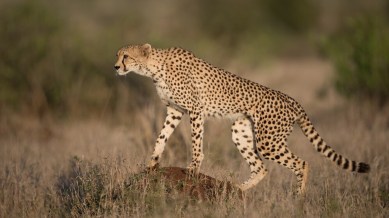Stay updated with the latest - Click here to follow us on Instagram
Exclusive | To revive cheetah prey base, wildlife officials mulled getting blackbucks from Agra
Cheetah project meetings also discussed surrogacy programme, moving old cheetahs to Gandhi Sagar. Both ideas eventually shelved.

Moving cheetahs too old to mate to Gandhi Sagar wildlife sanctuary and attempting a surrogacy programme at Bhopal’s Van Vihar were among the suggestions made at the Cheetah Project Steering Committee’s meetings that have since been shelved, The Indian Express has learnt.
Records of the committee’s meetings from December 2023 to April 2025 also reveal how Madhya Pradesh wildlife officials, struggling to revive the prey base at Kuno, suggested measures like introducing blackbucks from Agra’s Sikandara Monument premises to boost the prey base numbers.
monthly limit of free stories.
with an Express account.
As per records of the meetings, on February 19 this year, committee members suggested moving “cheetahs which are too old for mating to Gandhi Sagar for training and building purposes” and attempting “surrogacy in Van Vihar”.
A committee member, H S Negi, suggested, “One female, which may not be suitable for breeding, and the Agni-Vayu coalition can be moved to Gandhi Sagar.”
However, Madhya Pradesh wildlife officials and Cheetah Project Steering Committee members said this suggestion is not in the works.
Said a senior committee member, “There was a suggestion. However, there are no plans to act on this. The older cheetahs at Kuno have a good kill score and are healthy. The surrogacy aspect may have been a suggestion that was made. We have no plans to introduce it.”
In 2020, Ohio zoo officials announced that two cheetah cubs had been born through in vitro fertilisation and embryo transfer to a surrogate mother for the first time. This was their third attempt at in vitro fertilisation after decades of attempts at artificial insemination yielded no results.
Uttam Kumar Sharma, director of the Kuno National Park where most of the cheetahs are kept, told The Indian Express, “There is no plan to introduce surrogacy in the cheetah population.”
“Female cheetahs can reproduce well into their late reproductive stages. There is no plan to move old cheetahs to Gandhi Sagar. Our cheetahs in Gandhi Sagar are young, and we want them to give birth to healthy litters and spread the cheetah population,” Sharma said.
According to Madhya Pradesh wildlife officials, female cheetahs can produce litters until the end of their reproductive lifespan, which is typically around 10-12 years in the wild.
Records show that since December 2023, wildlife officials have been raising alarm over the prey base at Kuno and discussing “active prey augmentation” both within and outside cheetah enclosures. Wildlife officials have also been advocating for grassland revival to revive the prey base.
On June 18, 2024, Professor Qamar Qureshi of the Wildlife Institute of India issued a stark warning about the “paucity of prey base in Kuno”. According to him, the density of cheetal (spotted deer) was just two animals per square kilometre across a 400 sq km area, and 19 per sq km in a more limited 350 sq km zone.
Qureshi also raised concerns about the low population of chinkara at Gandhi Sagar. As per Mandsaur Divisional Forest Officer Sanjay Raikhare, the cheetal density there stood at 7.38 per sq km, while nilgai were found at a density of 4.35 per sq km.
During the same meeting, R N Mehrotra, former Principal Chief Conservator of Forests and Chief Wildlife Warden of Rajasthan, proposed introducing blackbucks into the landscape to strengthen the prey base.
On August 23, 2024, Qureshi noted that cheetal had established a stronghold within the 350 sq km core of the old Kuno sanctuary, where their density was 17.5 per sq km. However, in the rest of the protected area, deer numbers remained low at 1.5 per sq km.
Mehrotra had also suggested the introduction of antelopes, which constitute the main prey base of cheetahs in Namibia and South Africa. Kuno officials, meanwhile, were tasked with securing blackbucks from Shajapur with the help of South African experts. They also tied up with a chital breeding centre from Taal, which provided 62 chitals and constructed a Chital Bada at Bagcha village.
On April 9 this year, Mehrotra again flagged the paucity of prey and suggested “identifying drainage lines to Chambal and Kuno rivers” for water development.
S P Yadav, the committee adviser, informed the committee that a 60-hectare enclosure was being constructed in the Ochhapura range, which houses 70 spotted deer, with 30 pregnant females.
“The possibility of bringing spotted deer and blackbucks from zoo captivity… may please be explored… Further, the possibility of relocating blackbucks from Sikandara Monument premises, Agra, may also be explored. Reportedly, there are approximately 100 blackbucks there. Four-five passive captures, each of 10-15 blackbucks in the area where they are in abundance and creating problems like crop depredation, may be attempted and translocated to Kuno National Park,” Yadav had written to the committee.